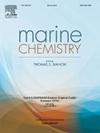调节夏季德雷克海峡和南极半岛北部海气二氧化碳交换的物理-生物过程
IF 2.5
3区 地球科学
Q2 CHEMISTRY, MULTIDISCIPLINARY
引用次数: 0
摘要
我们测定了海气二氧化碳交换,并研究了调节海面二氧化碳分压的主要物理-生物过程。这是通过分析鹦鹉螺号V号巡航(2019年1月)穿越德雷克海峡主要锋面和南极半岛北部几个不同的生物地球化学省期间测量的连续和离散海洋和大气变量的测量结果来完成的。主要研究结果表明,尽管北极锋北部(净光合作用调节的净CO2汇区)和南部(净呼吸调节的净CO2源区)的海气CO2通量值接近于~ 3 mmol m−2 d−1,但德雷克通道是一个弱的净CO2放出区(~ 0.1 mmol m−2 d−1)。另一方面,南极半岛北部地区表现出更不均匀的海气CO2交换行为,从中度的CO2净排放(~ 1.3 mmol m−2 d−1)(布兰斯菲尔德海峡、南极半岛西部和威德尔海大陆架)到中度(~−2.4 mmol m−2 d−1)或弱(~−0.1 mmol m−2 d−1)的CO2净排放(南极海峡周围和Gerlache海峡)。值得注意的是,在克拉伦斯岛以南的南极坡锋分岔涡的影响下,该地区的净CO2释放量大幅增加了~ 5 mmol m−2 d−1。预计在这一静止和反气旋特征中会出现二氧化碳脱气,但其量级比已知的估计高出约75%,这与加强的风和涡流动力学有关。除极锋以北以净光合作用为主外,净呼吸作用是研究区主要的生物过程。德雷克海峡和南极半岛北部海气二氧化碳交换行为的不均匀分布,加强了在区域和地方调查中更好地理解和关注二氧化碳化学和过程的精细分辨率的需求,特别是在一个遭受多种气候压力的地区,位于温暖和寒冷环境的过渡地带,以及以环极地方式连接南大洋生态系统的关键。本文章由计算机程序翻译,如有差异,请以英文原文为准。
Physical-biological processes regulating summer sea-air CO2 exchanges along the Drake Passage and northern Antarctic Peninsula
We determined the sea-air carbon dioxide (CO2) exchanges and investigated the main physical-biological processes responsible for regulating the sea surface partial pressure of CO2. This was done through the analysis of continuous and discrete measurements of oceanographic and atmospheric variables measured during the NAUTILUS V cruise (January 2019) crossing the main fronts along the Drake Passage and several distinct biogeochemical provinces along the northern Antarctic Peninsula. The main findings indicated that the Drake Passage acted as a weak net CO2 outgassing area (∼0.1 mmol m−2 d−1), although contrasting regions with close sea-air CO2 fluxes magnitudes of ∼3 mmol m−2 d−1 were identified north (a net CO2 sink zone regulated by net photosynthesis) and south (a net CO2 source zone regulated by net respiration) of the Polar Front. On the other hand, the northern Antarctic Peninsula areas demonstrated a more heterogeneous sea-air CO2 exchanges behaviour varying from moderate net CO2 outgassing of ∼1.3 mmol m−2 d−1 (Bransfield Strait, western Antarctic Peninsula and Weddell Sea continental shelves) to a moderate (∼ −2.4 mmol m−2 d−1) or weak (∼ −0.1 mmol m−2 d−1) net CO2 ingassing in Antarctic Sound surroundings and Gerlache Strait, respectively. It is interesting to note that a huge intensification of the net CO2 outgassing of ∼5 mmol m−2 d−1 was identified in the area under the influence of the Antarctic Slope Front bifurcation eddy south of Clarence Island. The CO2 outgassing is expected in this stationary and anticyclonic feature, but its magnitude was ∼75 % higher than the known estimate, which was associated with strengthen winds and eddy dynamics. Net respiration was the leading biological process occurring in the study area, except north of Polar Front where net photosynthesis prevailed. The patchy distribution of sea-air CO2 exchanges behaviour along the Drake Passage and northern Antarctic Peninsula reinforced the needs for better understanding and focus on finer resolution of the CO2 chemistry and processes at regional and local investigations, especially in a region suffering with multiple climate stressors, located in a transition zone of warm and cold environments, and key to connect the Southern Ocean ecosystems in a circumpolar way.
求助全文
通过发布文献求助,成功后即可免费获取论文全文。
去求助
来源期刊

Marine Chemistry
化学-海洋学
CiteScore
6.00
自引率
3.30%
发文量
70
审稿时长
4.5 months
期刊介绍:
Marine Chemistry is an international medium for the publication of original studies and occasional reviews in the field of chemistry in the marine environment, with emphasis on the dynamic approach. The journal endeavours to cover all aspects, from chemical processes to theoretical and experimental work, and, by providing a central channel of communication, to speed the flow of information in this relatively new and rapidly expanding discipline.
 求助内容:
求助内容: 应助结果提醒方式:
应助结果提醒方式:


